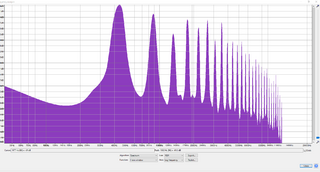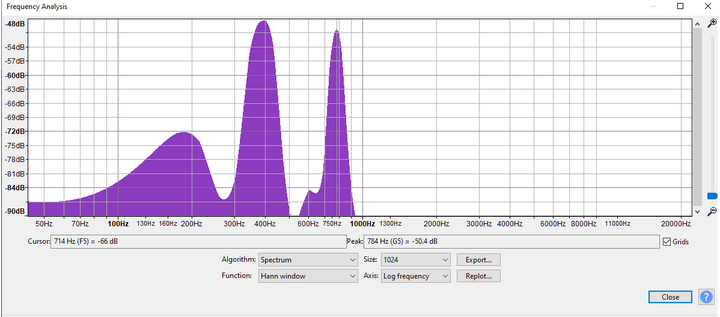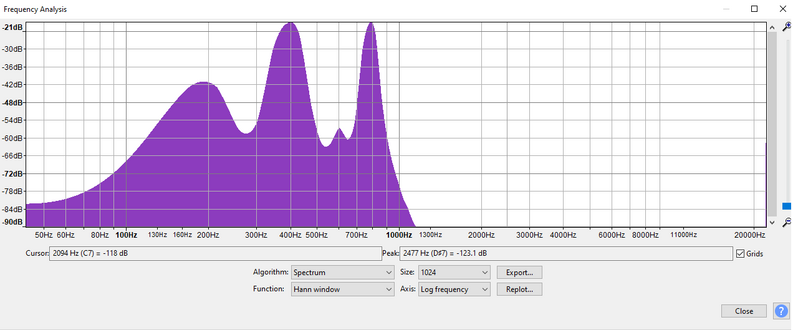PHYS341/2023/Project23
How Few Tones are Required to Replicate a Stringed Instrument? by Andrew Forrer
Which Instrument?
In order to answer the main question we first must figure out which instrument sound to replicate. The best candidate is an instrument with the fewest overtones. Fewer harmonics equals fewer pure tones. Ideally, the instrument produces a sound that is as close to a pure tone as possible while still having that distinctly stringed sound. There are many stringed instruments that exist in the world. However, using our knowledge of physics, we can narrow our choices down very quickly. For the sake of simplicity, instruments will be assessed based on the way they are typically played (i.e. no bowed guitars, one string fiddles, etc.). Also, no DIY novelty instruments such as this rubber band guitar: [1]


Bowed or Plucked?
For starters, we can eliminate any bowed instrument.
The "slip stick" nature of the bow means that it is constantly pulling and letting go of the string. Effectively, the bow is continuously providing energy to the string. This allows the higher harmonics to be preserved instead of dwindling out quickly like when you pluck the string. This delivers a very rich range of harmonics. That alone rules out anything played with a bow. That means no violins, violas, or anything else of the sort.
The Ideal Body
Finding the ideal body of the stringed instrument that produces the fewest harmonics is a difficult task as the whole point of the design process is to find out what specifications create the richest sound. Despite this, some instruments have savvier designs than others. For example, instruments with a very rich range of frequencies such as the violin have internals that are asymmetrical as that is the more optimal configuration. It can be assumed that an instrument whose body is simply a rectangular box would be less resonant than one that is more deliberately designed (such as a guitar).


Strings
Another source of harmonics in a stringed instrument are the strings themselves. There are several factors related to strings that will affect the timbre of an instrument.
Firstly, the material of the string will have a drastic impact on the overall sound of the instrument. For example, consider the difference between an acoustic guitar with nylon strings versus an acoustic with metal strings. Metal strings tend to produce a brighter and louder sound compared to nylon strings which produce a mellower and softer sound. What this means is that generally, metal strings have more harmonics that nylon. Our ideal instrument has strings not made of metal. The quality of these strings can also affect the overtones. High quality strings that are appropriately tensioned can produce more harmonics and contribute to a more resonance than low quality. However, for our purposes we aren't seeking out a low quality instrument.
Secondly, the amount of strings can add harmonics to an instruments sound. This is because of a phenomena known as resonance, where the vibrations of one string can produce vibrations in another if the vibrations in one string match the fundamental frequency of the other. This means that more strings equals more resonance which means more harmonics. Ideally, our instrument has as few strings as possible.
Summary
To summarize, the stringed instrument that produces the closest thing to a pure tone should have these features:
- It is played with either fingers or a pick. It is definitely not bowed.
- A body designed in a way that drives oscillations less effectively than other instruments.
- Ideally the instrument has only one string that is made of a lighter material.
The best fit for this description and the stringed instrument that produces the purest sound is the Vietnamese Dan Bau. [2]
The Dan Bau
The Vietnamese Dan Bau is a traditional musical instrument that has a unique sound that's similar to a Theremin (another instrument that's close to a pure tone). It is also known as the monochord or the "gourd lute". The Dan Bau is a single-stringed instrument that is played with one hand while the other hand manipulates the string to produce different pitches. The Dan Bau consists of a small, rectangular sound box made from a dried gourd or a wooden frame covered with a resonating skin, typically made from python or silk. A long metal string is stretched tightly along the length of the box and passes over a bridge at one end, while the other end is attached to a tuning peg. The pitch of the string is controlled by bending the string with the player's finger, while the other hand plucks or strikes the string with a pick or finger. It holds significant cultural and historical importance in Vietnam, and it continues to be cherished as a symbol of Vietnamese musical heritage. The acoustic version of the instrument is very quiet and only fit for small settings, the electronic version is much more popular.

The "Top-Down Approach"
Now that we've found the instrument with the least harmonically complicated sound, we will now see how many more frequencies we can trim off without losing the stringed essence of the sound. First We start with this original unedited note:

Now, we will remove the peak frequencies one by one in descending order. So, starting from the peak at 2342hz and going all the way down to the fundamental at 195hz.
There was minimal difference from cutting everything above 1000hz. The biggest change came when we cut all frequencies 600hz and above, which made the note sound like a pure tone:
We add back the frequencies above 600hz up to 1000hz and then look at the lower frequencies to see if we can shave off a few more tones. We cut out all tones below 100hz and are left with this:
This will be the version of the note we will attempt to replicate.

The "Bottom-Up Approach"
We will now try to build up this remaining sound from scratch by stacking pure tones. Using the image as a guide, we generate 4 tones. The result is a sound that's close to what we're trying to replicate. However, to make it sound like a note that's being played on an instrument we'll add a fade in followed by a slight amplification at the start of the sound to mimic the initial pluck of the string. We'll also add a fade out to mimic the sound of the instrument getting quieter as time goes on. This is the result:

Conclusion
The answer to the question "How few tones are required to sound like a stringed instrument?" from our work is 4. However, from the experience of putting the tones together, we learned that there is more to what makes something "sound" like a string than just the tones it is comprised of. For example, the fades had to be used to give the stack of tones a more lifelike feel. It's incredible what can be accomplished with just a few basic waves.